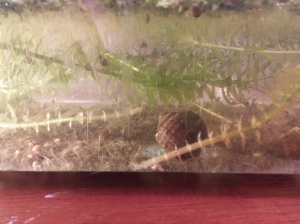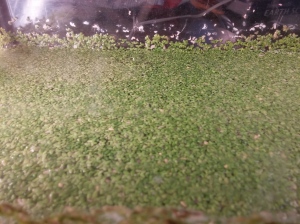It might seem counter-intuitive, but keeping some stocks of living organisms around can make materials management for biology classes much easier. One of my favorite tools is a mini-pond that I keep on a windowsill.
It is a simple lidded plastic box (originally a small animal carrier) without any filters, pumps, heaters, or artificial lights. I initially put mystery snails, elodea, and duckweed into it, all purchased from a scientific supply house. At least one of those organisms was packed with “bonus” critters, so I also have tiny, unidentified aquatic snails and even tinier, unidentified crustaceans living in the tank. Of course, there are a multitude of microscopic creatures as well.

Maintenance is exceptionally simple. About once a month, I leave a jar of tap water out for 24 hours and then pour it into the tank to compensate for evaporation. It is important to age the water because many of the organisms present in the mini-pond are sensitive to chlorine. I throw in a food pellet designed for aquatic herbivores once in a while. In return for this minimal effort, I get:
- A ready source of pond water (for protist observation) that is available even when local ponds have frozen over.
- All the duckweed I need for population growth experiments and comparative plant anatomy.
- Elodea for studies of osmosis and the anatomy of plant cells.
- Snails ready to plunge into dilute bromothymol blue solutions for experiments about cellular respiration. (This doesn’t harm the snails, FYI.)

My mini-pond saves time, money, and effort. It’s also exceptionally useful to have some “back-up” critters around for when something goes wrong with a scheduled shipment of live materials. I’d recommend keeping something like this to almost any biology teacher.